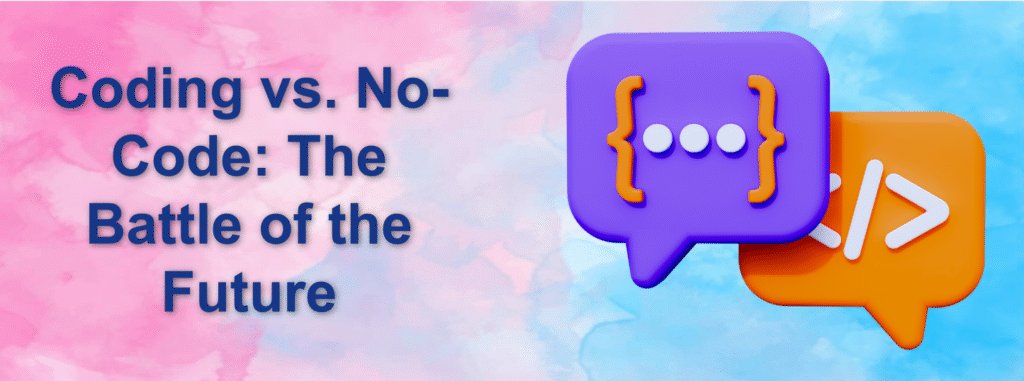Coding vs. No-Code: The Battle of the Future

Coding vs. No-Code: The Future of Software Development
Technology has always aimed to simplify our lives, and software development is no different. While traditional coding has been the backbone of digital innovation for years, the emergence of no-code platforms is transforming the landscape. The ongoing discussion about coding versus no-code solutions raises significant questions regarding the future of software development. Will coding continue to be the benchmark, or could no-code platforms take its place? This article delves into both perspectives, examining their advantages, drawbacks, and potential effects on the future.
Understanding Coding
What is Coding?
Coding is the act of writing instructions in programming languages like Python, JavaScript, C++, and Java to develop software applications. Developers create these instructions in text-based environments, utilizing algorithms, data structures, and frameworks to construct intricate systems.
Advantages of Coding
- Flexibility and Customization: Coding empowers developers to craft unique applications that meet specific requirements, free from the constraints of prebuilt templates or drag-and-drop features.
- Scalability: Large-scale applications demand robust architectures, which are more easily achieved through traditional coding.
- Performance Optimization: Developers have the ability to fine-tune applications for speed, efficiency, and security.
- Integration: Coding facilitates seamless integration with APIs, databases, and third-party services, making it ideal for enterprise-level applications.
Limitations of Coding
- Steep Learning Curve: Gaining proficiency in programming languages requires years of dedication and experience.
- Time-Consuming: The processes of developing and debugging code can be lengthy.
- Expensive: Recruiting skilled developers can be a significant financial burden for startups and small businesses.
Exploring No-Code Platforms
What is No-Code?
No-code platforms allow users to create applications without the need for traditional programming skills. These platforms offer visual development tools, including drag-and-drop interfaces, prebuilt components, and automation for workflows.
Some popular no-code platforms are:
- Bubble (for web applications)
- Zapier (for automating workflows)
- Airtable (for managing databases)
- Webflow (for building websites)
Advantages of No-Code
- Accessibility: No-code platforms enable non-technical users, allowing business professionals to create apps without needing programming knowledge.
- Speed: Projects that typically take months to develop with code can be completed in just weeks using no-code tools.
- Cost-Effective: No-code solutions reduce the need for large development teams.
- Rapid Prototyping: Businesses can quickly test their ideas without making significant investments in development.
Limitations of No-Code
- Limited Customization: Users may find themselves constrained by the platform’s features.
- Scalability Issues: No-code applications might face performance and scalability challenges as they expand.
- Security Concerns: Since no-code platforms are hosted on third-party servers, there are potential security risks involved.
- Vendor Lock-In: Users may become reliant on specific platforms, making it hard to switch to alternatives.
Will No-Code Replace Coding?
No-code platforms are making software development more accessible, but they are unlikely to completely replace traditional coding. Instead, both will continue to exist side by side. Here’s why:
The Rise of Hybrid Approaches
Many platforms now provide low-code options, enabling users to blend visual programming with custom code. This hybrid model effectively connects no-code and traditional coding, offering both flexibility and ease of use.
Enterprise Needs and Customization
Large organizations often require custom-built software solutions that no-code platforms cannot fully provide. Since offers deeper customization and control, businesses with complex needs will continue to rely on traditional development methods.
Changing Developer Roles
Rather than eliminating the need for developers, no-code tools may transform their roles. Developers may focus more on solution architecture, performance optimization, and security assurance rather than writing every line of code manually.
Conclusion
The discussion between coding and no-code isn’t about one overshadowing the other; it’s about making technology more accessible. No-code platforms empower those without a coding background, while traditional coding remains vital for developing complex applications. The future of software development will find a balance between these two approaches, enabling businesses and individuals to select the most suitable tools for their requirements. Whether you are a developer or a business owner, grasping both coding and no-code will be essential for navigating the future digital landscape.
USEFULL LINKS:
https://awaraj.com/custom-software-development/
https://awaraj.com/no-code-development-services/
https://awaraj.com/low-code-application-development/

